Note. Some variants may require an appropriate square head wrench to remove the oil pan drain plug. These wrenches are available from many auto parts stores or your Peugeot/Citroen dealer.
1. Changing the engine oil and oil filter frequently is the most important preventive maintenance you can do yourself. Oil becomes thinner and dirtier as it ages, leading to premature engine wear.
2. Before starting the procedure, prepare all the necessary tools and materials. Have enough clean rags and old newspapers to clean up splashes and spilled oil. Ideally, the engine oil should be warm: it will be easier to drain, and the sludge will be better flushed out with it. Be careful! When working under the vehicle, do not touch the exhaust system or other hot parts of the engine. To avoid scalding, skin irritation and protection from various harmful impurities contained in used engine oil, it is recommended to wear gloves for this work. Access to the bottom of the car is greatly improved by raising the car on a lift, placing it on a flyover or jacking it up and placing secure supports under it (see «Lifting and placing the car on supports»). Whichever method is chosen, the car must be level, and if it is tilted, the drain plug must be at the lowest point.
3. Loosen the drain plug about half a turn; on some models, a square head wrench may be required to loosen the plug (pic. 3.3). Place a suitable container under the drain plug and unscrew the plug completely. If possible, try to keep the plug pressed against the oil pan on the last two turns (see «.Haynes advises»), Remove the sealing washer from the drain plug.
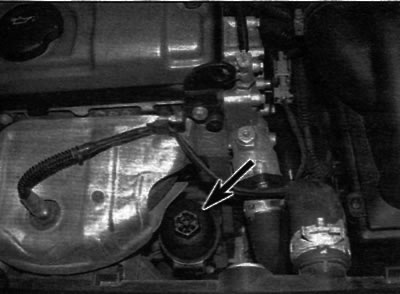
Pic. 3.3. Releasing the drain plug with a square head wrench
Advice. After turning the plug all the way out, keep it pressed against the sump, and then sharply move it to the side so that the flow of oil from the sump goes into the container, and not into your sleeve.
4. Let the oil drain. Please note that as the oil flow slows down and turns into a trickle, it may be necessary to move the container.
5. When all the oil is drained, wipe the drain plug with a clean rag. Replace the sealing washer on the plug with a new one. Clean the area around the drain hole and replace the drain plug. Tighten the plug securely.
6. Move the container under the oil filter, which is located on the front side of the cylinder block.
7. On earlier models with a 1.4L engine, the oil filter is a disposable metal case screwed into the front of the cylinder block. However, on newer 1.4L models and all models with a 1.6L engine, the oil filter consists of a disposable filter element inserted into a plastic housing. The housing is located on the front of the cylinder block next to the radiator hoses (pic. 3.7). Proceed as described below according to the type of filter.
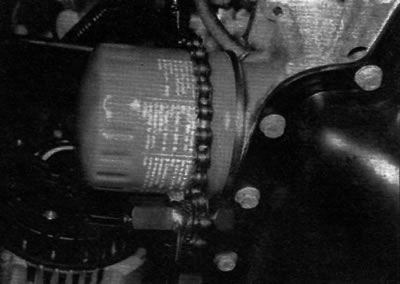
Pic. 3.7. The location of the oil filter housing with a replaceable filter element (marked with an arrow) (newer models)
Metal housing filter
8. If necessary, using the oil filter removal tool, first release the filter and then unscrew it by hand (pic. 3.8). Drain the oil from the old filter into a suitable container. To completely empty «old» filter before disposing of it, punch at least two holes in the bottom of the filter housing and drain any remaining oil through them into a suitable container.
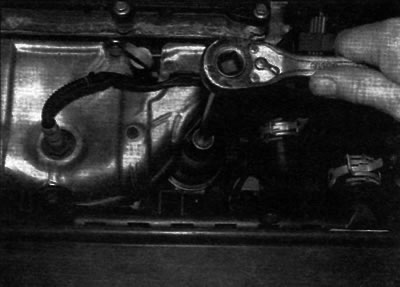
Pic. 3.8. Using the oil filter removal tool, release the metal housing oil filter
9. Use a clean rag to remove all traces of oil, dirt, and sediment from the engine seating area where the filter is installed. Inspect the old filter to make sure the rubber o-ring is not stuck to the engine. If it sticks, carefully peel it off.
10. Apply a thin layer of clean engine oil to the O-ring on the new filter. Screw the filter back into place. Tighten the filter securely using only your hands - do not use any tool.
Filter with replaceable filter element
11. On these engines, the filter element is attached to the filter cover. Using a socket or wrench, loosen and remove the top cover of the filter. Prepare for oil to flow out and remove the o-ring from the cap (pic. 3.11, a, b).
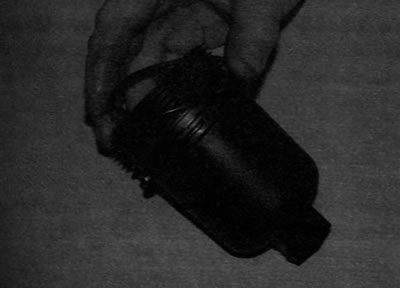
Pic. 3.11, a. Release and remove the filter cover...
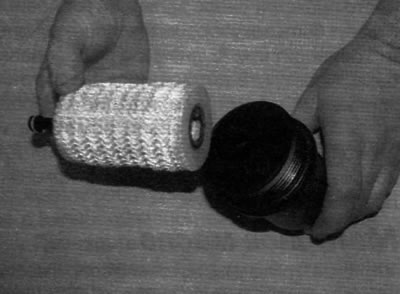
Pic. 3.11b....and remove the o-ring
12. Remove the filter element from the filter cover.
13. Use a clean rag to remove all traces of oil, dirt, and sediment from the inside and outside of the filter cover.
14. Insert a new filter element into the cover, then apply a little clean engine oil to the new o-ring and install it on the filter cover (pic. 3.14, a, b).
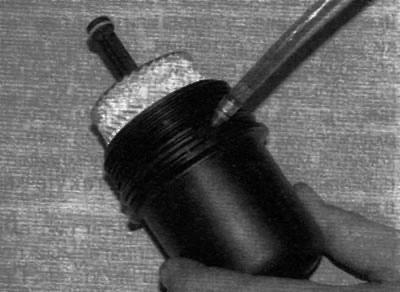
Pic. 3.14b....and apply some clean engine oil to the O-ring
15. Install the filter with cover on the body and tighten the cover to the specified torque.
All engines
16. Remove the container with drained oil and all tools from under the car. Lower the car.
17. Remove the dipstick and unscrew the oil filler cap on the cylinder head cover or on the oil filler/breather neck. Refuel the engine with new oil of the appropriate brand (see «Lubricants and operating fluids»). Use a funnel to avoid spilling oil. First pour half the prescribed amount of oil and wait a few minutes for the oil to drain into the pan. Continue to add oil in small portions until the level reaches the bottom mark on the dipstick. Adding approximately 1.5 liters of oil will bring the level up to the upper mark on the dipstick. Reinstall the oil filler cap.
18. Start the engine and let it idle for a few minutes while checking the oil filter seal area and sump drain plug for leaks. Please note that when starting the engine, the low oil pressure warning light may only go out after a few seconds. This is because the oil must pass through the new oil filter and engine oil galleries before the pressure builds up.
19. Stop the engine and wait a few minutes for the oil to drain into the sump. Now that the new oil has completely filled the lines and filter, check the level again on the dipstick and add more oil if necessary.
20. Dispose of used engine oil and filter properly. For more information, see the section «General Repair Tips» in the application. Don't throw away «old» filter in a container with household waste. As a rule, many stations that change engine oil have a container for the disposal of used filters.
